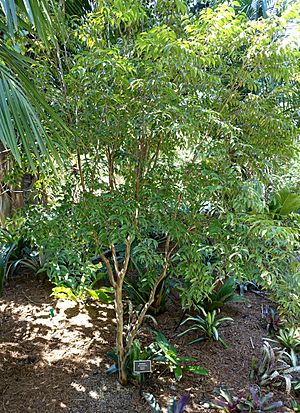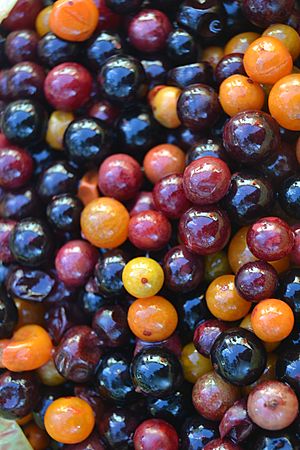Cambuizeiro facts for kids
Quick facts for kids Cambuizeiro |
|
|---|---|
 |
|
| Conservation status | |
| Scientific classification | |
| Genus: |
Myrciaria
|
| Species: |
floribunda
|
The Guavaberry (scientific name: Myrciaria floribunda) is a cool plant from the Myrtaceae family. You might also hear it called cambuizeiro or rumberry. This plant grows in warm, humid places near coasts in South and Central America. It can be found up to 300 meters (about 984 feet) above sea level.
Don't mix up the guavaberry with the regular guava fruit! Even though they sound similar, they are different. The guavaberry is actually a close relative of another fruit called camu camu.
What it Looks Like
Guavaberry trees grow slowly. They can reach a height of about 12 to 20 meters (around 39 to 66 feet). Their branches are a pretty red-brown color. When they bloom, they have small flowers that are pink and white.
The fruit of the guavaberry is quite small, about half the size of a cherry. It can be yellow-orange, dark-red, or even purple. Inside, the fruit has a small amount of clear, juicy flesh around a hard seed, or "stone." It tastes a bit tangy, like a guava, but also moderately sweet. Guavaberries are packed with vitamin C, especially the darker colored ones!
These trees can look a bit different from one another, even within the same species. This is because of their natural variety.
Where it Grows
Guavaberry trees grow naturally in many places. You can find them wild in Central America and South America. This includes countries like Argentina, Belize, Bolivia, Brazil, Colombia, and Costa Rica. They also grow on many Caribbean islands.
People have also brought guavaberry trees to other parts of the world. Now, they grow in places like Florida, Hawaii, Bermuda, the Philippines, and Tanzania.
How People Use It

Guavaberries are used to make tasty jams and drinks. One popular drink is guavaberry liqueur. This special drink is made with rum and is a common treat during Christmas on many islands. It's especially popular in Sint Maarten and the Virgin Islands. Long ago, settlers from Denmark and Holland learned how to use the fruit to flavor rum.
In the Dominican Republic, the guavaberry is linked to the town of San Pedro de Macorís. Many people there have family roots from the Eastern Caribbean islands.
Another Christmas drink is Guavaberry coquito from Puerto Rico. This creamy drink is made with spices, guavaberry, milk, sugar, coconut milk, eggs, and rum. It's a festive holiday favorite!
See also
 In Spanish: Cabo de chivo para niños
In Spanish: Cabo de chivo para niños



